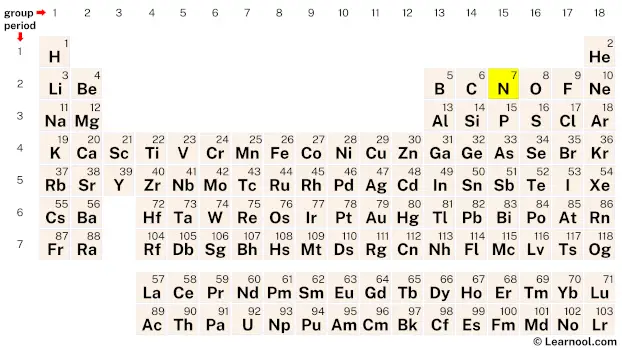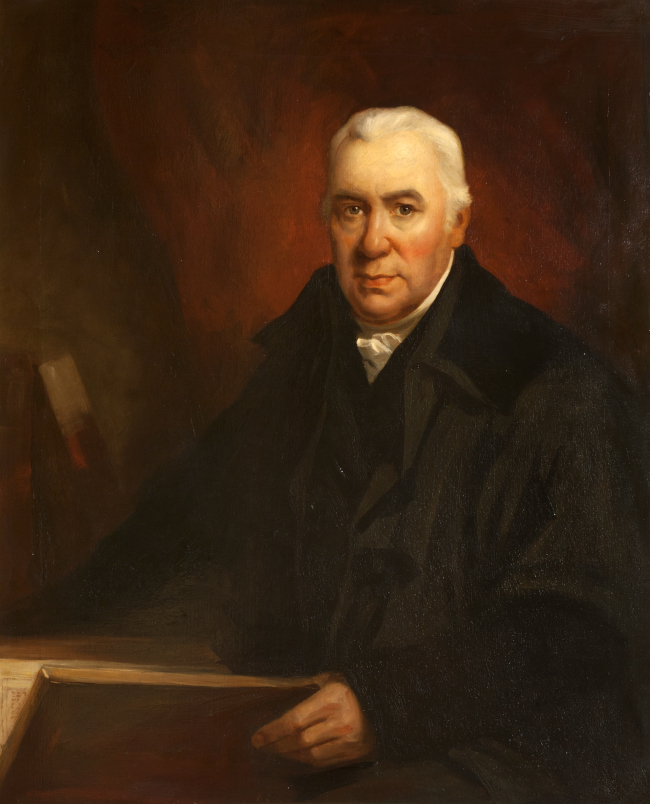
Nitrogen (N) is a chemical element of the periodic table, located in the group 15 and the period 2, and is having the atomic number 7. It is a colorless, odorless, tasteless gas, whose name comes from the Greek word “nitron” and “genes”, which means native soda forming. It is a reactive nonmetal and is the 30th most abundant element on earth. It is the first element in the pnictogen group and is the lightest element of the pnictogen group.
On periodic table
| group | ⇨ | 1 | 2 | 3 | 4 | 5 | 6 | 7 | 8 | 9 | 10 | 11 | 12 | 13 | 14 | 15 | 16 | 17 | 18 |
| period | ⇩ | ||||||||||||||||||
| 1 | 1 H  Hydrogen |
2 He  Helium |
|||||||||||||||||
| 2 | 3 Li  Lithium |
4 Be  Beryllium |
5 B  Boron |
6 C  Carbon |
7 N Nitrogen |
8 O  Oxygen |
9 F  Fluorine |
10 Ne  Neon |
|||||||||||
| 3 | 11 Na  Sodium |
12 Mg  Magnesium |
13 Al  Aluminium |
14 Si Silicon |
15 P  Phosphorus |
16 S  Sulfur |
17 Cl  Chlorine |
18 Ar  Argon |
|||||||||||
| 4 | 19 K  Potassium |
20 Ca  Calcium |
21 Sc  Scandium |
22 Ti  Titanium |
23 V  Vanadium |
24 Cr  Chromium |
25 Mn  Manganese |
26 Fe  Iron |
27 Co  Cobalt |
28 Ni  Nickel |
29 Cu  Copper |
30 Zn  Zinc |
31 Ga  Gallium |
32 Ge  Germanium |
33 As  Arsenic |
34 Se  Selenium |
35 Br  Bromine |
36 Kr  Krypton |
|
| 5 | 37 Rb  Rubidium |
38 Sr  Strontium |
39 Y  Yttrium |
40 Zr  Zirconium |
41 Nb  Niobium |
42 Mo  Molybdenum |
43 Tc  Technetium |
44 Ru  Ruthenium |
45 Rh  Rhodium |
46 Pd  Palladium |
47 Ag  Silver |
48 Cd  Cadmium |
49 In  Indium |
50 Sn  Tin |
51 Sb  Antimony |
52 Te  Tellurium |
53 I  Iodine |
54 Xe  Xenon |
|
| 6 | 55 Cs  Caesium |
56 Ba  Barium |
72 Hf  Hafnium |
73 Ta  Tantalum |
74 W  Tungsten |
75 Re  Rhenium |
76 Os  Osmium |
77 Ir  Iridium |
78 Pt  Platinum |
79 Au  Gold |
80 Hg  Mercury |
81 Tl  Thallium |
82 Pb  Lead |
83 Bi  Bismuth |
84 Po  Polonium |
85 At  Astatine |
86 Rn  Radon |
||
| 7 | 87 Fr  Francium |
88 Ra  Radium |
104 Rf  Rutherfordium |
105 Db  Dubnium |
106 Sg  Seaborgium |
107 Bh  Bohrium |
108 Hs  Hassium |
109 Mt  Meitnerium |
110 Ds  Darmstadtium |
111 Rg  Roentgenium |
112 Cn  Copernicium |
113 Nh  Nihonium |
114 Fl  Flerovium |
115 Mc  Moscovium |
116 Lv  Livermorium |
117 Ts  Tennessine |
118 Og  Oganesson |
||
| 57 La  Lanthanum |
58 Ce  Cerium |
59 Pr  Praseodymium |
60 Nd  Neodymium |
61 Pm  Promethium |
62 Sm  Samarium |
63 Eu  Europium |
64 Gd  Gadolinium |
65 Tb  Terbium |
66 Dy  Dysprosium |
67 Ho  Holmium |
68 Er  Erbium |
69 Tm  Thulium |
70 Yb  Ytterbium |
71 Lu  Lutetium |
|||||
| 89 Ac  Actinium |
90 Th  Thorium |
91 Pa  Protactinium |
92 U  Uranium |
93 Np  Neptunium |
94 Pu  Plutonium |
95 Am  Americium |
96 Cm  Curium |
97 Bk  Berkelium |
98 Cf  Californium |
99 Es  Einsteinium |
100 Fm  Fermium |
101 Md  Mendelevium |
102 No  Nobelium |
103 Lr  Lawrencium |
|||||
| – p block |
Nitrogen is a p-block element, situated in the fifteenth column, also known as the nitrogen group of the periodic table, between carbon (C) and oxygen (O). It has the atomic number 7 and is denoted by the symbol N.
Element information
 |
|
 |
|
| Origin of name | Greek word “nitron” and “genes” (which means native soda forming) |
| Symbol | N |
| Atomic number (Z) | 7 |
| Atomic mass | 14.0067 u |
| Block | p-block |
| Group | 15 (nitrogen group) |
| Period | 2 |
| Classification | Reactive nonmetal |
| Covalent radius | 71±1 pm |
| Van der Waals radius | 155 pm |
| Melting point | -209.86 ℃, -345.75 ℉, 63.23 K |
| Boiling point | -195.795 ℃, -320.431 ℉, 77.355 K |
| Electron configuration | [He] 2s2 2p3 |
| Electrons per shell | 2, 5 |
| Crystal structure | Hexagonal |
| Phase at r.t | Gas |
| Density near r.t | 1.2506 g/L at 0 ℃, 1013 mbar |
| Main isotopes | Nitrogen-14, Nitrogen-15 |
| Natural occurrence | Primordial |
| Oxidation state | -3, +3, +5 |
| Electronegativity (Pauling scale) | 3.04 |
| Protons Neutrons Electrons |
7 7 7 |
| Learn how to find: Nitrogen protons neutrons electrons | |
| Valence electrons | 5 |
| Learn how to find: Nitrogen valence electrons | |
| CAS number | 17778-88-0 |
| Discovered by | Daniel Rutherford in 1772 |
History

Nitrogen was discovered in 1772 by the Scottish physician and chemist Daniel Rutherford. Rutherford conducted an experiment in which he removed all of the oxygen and carbon dioxide from a confined space, then burned a candle in it until it went out. He then showed that the remaining gas would not support combustion or respiration, and he called it “noxious air.”
Antoine Laurent Lavoisier later discovered that the gas, which he named “azote” (meaning “without life” in Greek), was the same as that produced when nitre (potassium nitrate) was heated, and which was known to be an essential component of air. The name “nitrogen” was coined by the French chemist Jean-Antoine Chaptal in 1790.
During the 19th century, nitrogen was primarily obtained by collecting it from the atmosphere, using various methods such as cooling and compressing air, and then removing the oxygen and other impurities. In the early 20th century, new methods for producing nitrogen were developed, such as the Haber-Bosch process, which involves reacting nitrogen and hydrogen gases at high temperatures and pressures to produce ammonia, which can then be used as a fertilizer or a feedstock for the production of other chemicals.
Today, nitrogen is an essential element for life and is used in a wide range of applications, including in the production of fertilizers, explosives, and semiconductors, as well as in the food and beverage industry for packaging and preservation purposes.
Occurrence
Nitrogen is the seventh most abundant element in the universe, making up around 78% of the Earth’s atmosphere. The nitrogen in the atmosphere exists as diatomic nitrogen gas (N2), which is highly unreactive and is not directly available for use by most living organisms. Nitrogen is also found in various forms in the Earth’s crust, including as nitrates and nitrites in soils and sediments. These compounds are essential for the growth of plants and are converted into organic nitrogen compounds by nitrogen-fixing bacteria.
In addition to its presence in the atmosphere and the Earth’s crust, nitrogen is also found in various organic and inorganic compounds, such as proteins, DNA, and ammonia.
Production
Nitrogen is primarily produced through a process called the Haber-Bosch process, which involves the reaction of nitrogen gas and hydrogen gas under high pressure and temperature in the presence of a catalyst. This process was first developed in the early 20th century by German chemist Fritz Haber and Carl Bosch and revolutionized agriculture by allowing for the production of large quantities of ammonia-based fertilizers.
Another method of producing nitrogen is through the separation of air. This involves cooling and compressing air to separate it into its various components, including nitrogen gas. This process is commonly used in the production of industrial gases and in the manufacture of electronic components.
Nitrogen can also be produced through biological processes such as nitrogen fixation, in which certain bacteria and other organisms convert atmospheric nitrogen into a form that can be used by plants and other organisms. This process is essential for the growth of plants and is a key component of many agricultural practices.
Properties
Physical properties
Nitrogen is a colorless, odorless, and tasteless gas at room temperature and standard pressure.
It has a melting point of -209.86 ℃ and a boiling point of -195.795 ℃.
Nitrogen is less dense than air and is slightly soluble in water.
Chemical properties
Nitrogen is a highly unreactive element and exists in nature as a diatomic molecule (N2).
Nitrogen has five valence electrons, and thus requires three more electrons to complete its octet. As a result, it forms strong triple bonds with itself and other elements.
Nitrogen can undergo various chemical reactions such as oxidation, reduction, and nitration.
Other properties
Nitrogen has a relatively low thermal conductivity and is often used as an insulating gas in industry.
It is an essential element for living organisms and is a major component of nucleic acids, amino acids, and proteins.
Nitrogen gas is widely used in the food packaging industry to prevent spoilage and extend the shelf life of products.
Applications
Fertilizers
Nitrogen is a key component of fertilizers as it is an essential element required for plant growth. Ammonia, which is made from nitrogen, is the main ingredient in many nitrogen fertilizers.
Food industry
Nitrogen is used in the food industry for a variety of purposes such as packaging of snack foods like potato chips, to keep them fresh and prevent them from becoming stale. It is also used to prevent the oxidation of oils and fats in foods, which can cause them to become rancid.
Electronics
Nitrogen is used in the production of electronics to create an oxygen-free environment. This prevents oxidation and contamination of the materials being produced, resulting in higher quality products.
Pharmaceutical industry
Nitrogen is used in the pharmaceutical industry for a variety of purposes such as purging equipment, storing drugs, and freeze drying.
Medical industry
Liquid nitrogen is used in medicine to freeze and remove abnormal skin tissue, as well as to treat certain types of cancer.
Automotive industry
Nitrogen is used in tires to increase their lifespan and improve their performance. Nitrogen is less likely to escape from the tire, resulting in more stable tire pressure and better gas mileage.
Aerospace industry
Nitrogen is used in the aerospace industry to pressurize fuel tanks and to purge systems that require an oxygen-free environment.
Oil and gas industry
Nitrogen is used to enhance oil recovery, to purge equipment, and as a tool for drilling and completion operations.
Interesting facts
Nitrogen is the most abundant gas in the Earth’s atmosphere, making up about 78% of the air we breathe.
Nitrogen is a non-metallic element and is classified as a “diatomic” molecule because it exists as two nitrogen atoms bonded together.
Nitrogen is essential for life on Earth as it is a key component of proteins, nucleic acids, and other biological molecules.
Nitrogen gas is used in a variety of industrial applications such as in the production of ammonia for fertilizers, in the manufacture of electronic components, and in food packaging to prevent spoilage.
Liquid nitrogen is used in cryogenics to freeze and preserve biological samples and tissues.
Nitrogen is also used in the medical field to create “nitrogen blankets” for patients with severe burns to protect against infection and to accelerate the healing process.
Nitrogen gas is also used in the food and beverage industry to create foams, such as in whipped cream and beer.
Nitrogen has two stable isotopes, with nitrogen-14 being the most abundant, while nitrogen-15 is used to determine the fertilizer use efficiency of crops as it is an essential plant nutrient.
Nitrogen gas is odorless, colorless, and tasteless, which makes it difficult to detect.
The discovery of nitrogen is credited to Scottish chemist Daniel Rutherford in 1772, who first isolated the gas by removing oxygen and carbon dioxide from air.
Related
More elements
External links
- https://www.rsc.org/periodic-table/element/7/nitrogen
- https://www.britannica.com/science/nitrogen
- https://en.wikipedia.org/wiki/Nitrogen
- https://pubchem.ncbi.nlm.nih.gov/element/Nitrogen
- https://education.jlab.org/itselemental/ele007.html
- https://www.ducksters.com/science/chemistry/nitrogen.php
- https://www.chemicool.com/elements/nitrogen.html
- https://www.livescience.com/28726-nitrogen.html
Deep
Learnool.com was founded by Deep Rana, who is a mechanical engineer by profession and a blogger by passion. He has a good conceptual knowledge on different educational topics and he provides the same on this website. He loves to learn something new everyday and believes that the best utilization of free time is developing a new skill.
